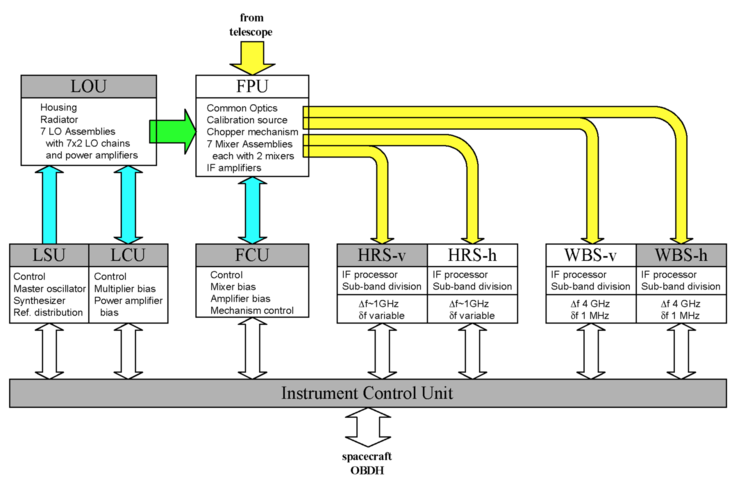
V.B.2.b.i. HIFI
It is useful to compare the Herschel heterodyne instrument HIFI with that of SWAS. HIFI uses helium temperature Superconductor-Insulator-Superconductor (SIS) and Hot Electron Bolometer (HEB) mixers. The much lower local oscillator power requirements of these mixers aids in the design of a relatively broad banded system, with continuous frequency coverage of the 480-1250 GHz band, and also of the 1410-1910 bands. Figure V.B.2.b.i-1 shows a functional block diagram. Inspection of this figure shows that Herschel is similar to SWAS and other heterodyne THz astronomical receivers. However, it is much more complex, with seven pairs (one for each polarization) of mixers spread over its much wider spectral range. It’s IF section also uses Acousto-Optic Modulators (AOMs) for multiplex operation, but supplements them with auto-correlator spectrometers to provide a variety of combinations of bandwidth and resolution.

Figure V.B.2.b.i-1 A functional block diagram of heterodyne receiver HIFI on FIRST.
In many respects the greatest challenge for a heterodyne system operating at THz frequencies is the production of adequate local oscillator power. HIFI uses 14 separate local oscillator sub-bands. These synthesized local oscillators will consist of K- to W-band multipliers, high power MMIC amplifiers operating in 5 bands between 71 and 113 GHz and high frequency planar diode multipliers.[1] The high spectral resolution of this heterodyne instrument, combined with the narrow spectral features of low temperature astrophysical molecules, makes Herschel an ideal instrument to study a variety of astrophysical processes. Its wide spectral coverage can provide massive redundancy for the determination of cosmic abundances and interstellar chemistry. Its high resolution is essential to avoid spectral confusion and line blending in studies of dynamically evolving regions.
Back to V.B.2.b. Herschel Space Observatory